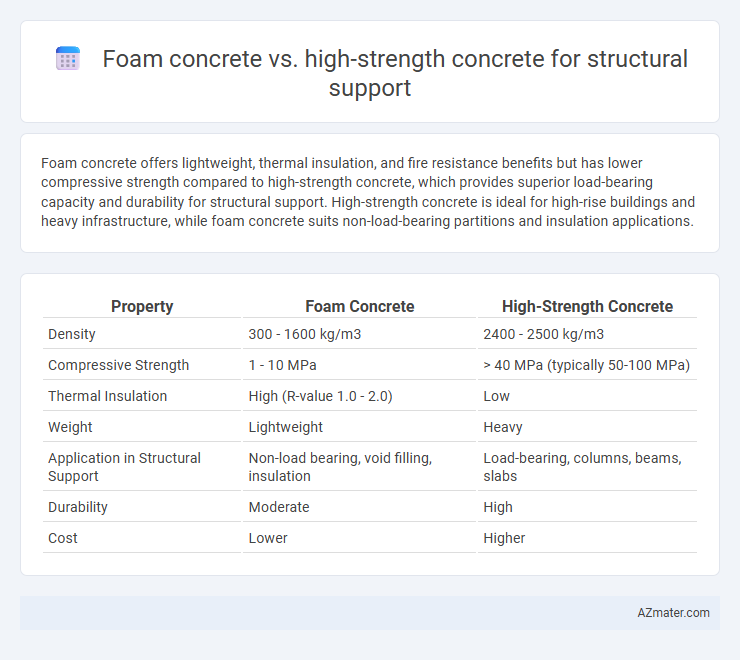Foam concrete offers lightweight, thermal insulation, and fire resistance benefits but has lower compressive strength compared to high-strength concrete, which provides superior load-bearing capacity and durability for structural support. High-strength concrete is ideal for high-rise buildings and heavy infrastructure, while foam concrete suits non-load-bearing partitions and insulation applications.
Table of Comparison
| Property | Foam Concrete | High-Strength Concrete |
|---|---|---|
| Density | 300 - 1600 kg/m3 | 2400 - 2500 kg/m3 |
| Compressive Strength | 1 - 10 MPa | > 40 MPa (typically 50-100 MPa) |
| Thermal Insulation | High (R-value 1.0 - 2.0) | Low |
| Weight | Lightweight | Heavy |
| Application in Structural Support | Non-load bearing, void filling, insulation | Load-bearing, columns, beams, slabs |
| Durability | Moderate | High |
| Cost | Lower | Higher |
Introduction to Structural Concrete Types
Foam concrete, characterized by its lightweight and thermal insulation properties, is commonly used in non-load-bearing applications and void filling, offering ease of handling with reduced density ranging from 400 to 1600 kg/m3. High-strength concrete, defined by a compressive strength exceeding 40 MPa, is engineered for critical structural components requiring superior load-bearing capacity and durability. The choice between foam concrete and high-strength concrete depends on specific structural demands, where foam concrete enhances energy efficiency and reduces dead load, while high-strength concrete ensures integrity in columns, beams, and slabs subjected to high stress.
Overview of Foam Concrete
Foam concrete is a lightweight, aerated material characterized by its low density, thermal insulation, and high fire resistance, making it ideal for non-load bearing walls and void filling. Unlike high-strength concrete, which is designed to bear significant structural loads with compressive strengths exceeding 40 MPa, foam concrete offers compressive strengths typically ranging from 1 to 10 MPa. Its cellular structure reduces weight and improves thermal performance, but limits its application in primary structural support where high load capacity is required.
Overview of High-Strength Concrete
High-strength concrete (HSC) is characterized by a compressive strength exceeding 6,000 psi (41 MPa), making it ideal for structural support in high-rise buildings, bridges, and heavy-load infrastructures. This concrete type achieves enhanced durability and load-bearing capacity through optimized mix designs incorporating high-quality cement, low water-cement ratios, and supplementary cementitious materials like silica fume. Compared to foam concrete, HSC offers superior mechanical properties and long-term performance, essential for demanding structural applications requiring resilience and stability.
Composition and Material Properties
Foam concrete consists of a cementitious matrix mixed with stable air bubbles, resulting in low density and high thermal insulation, but relatively low compressive strength typically ranging from 3 to 20 MPa. High-strength concrete incorporates a dense mix of cement, fine and coarse aggregates, and often supplementary cementitious materials like silica fume or fly ash, achieving compressive strengths exceeding 50 MPa, with enhanced durability and load-bearing capacity. The porous structure of foam concrete reduces dead loads but limits structural support applications, whereas high-strength concrete's dense microstructure provides superior mechanical properties ideal for critical load-bearing elements.
Structural Performance Comparison
Foam concrete offers enhanced thermal insulation and reduced density, making it ideal for non-load-bearing applications, but its compressive strength typically ranges between 2 to 10 MPa, limiting its suitability for primary structural support. High-strength concrete, with compressive strengths exceeding 40 MPa and often reaching up to 100 MPa, provides superior load-bearing capacity and durability, essential for critical structural components such as columns and beams. The structural performance comparison reveals that while foam concrete excels in lightweight construction and thermal efficiency, high-strength concrete remains the preferred choice for demanding structural support due to its exceptional mechanical properties and resistance to crushing.
Load-Bearing Capacity Differences
Foam concrete exhibits lower load-bearing capacity compared to high-strength concrete due to its reduced density and higher porosity, making it suitable for non-structural or lightweight applications. High-strength concrete, characterized by compressive strength exceeding 6,000 psi, provides superior structural support and is ideal for load-bearing elements in high-rise buildings and infrastructure projects. The density of foam concrete typically ranges between 400-1,600 kg/m3, whereas high-strength concrete density is about 2,400 kg/m3, reflecting its enhanced load-bearing performance.
Durability and Longevity
Foam concrete offers excellent thermal insulation and lightweight properties but typically exhibits lower compressive strength and durability compared to high-strength concrete, limiting its use in heavy structural support. High-strength concrete provides superior load-bearing capacity and enhanced resistance to environmental degradation, making it ideal for long-lasting infrastructure and critical structural applications. Its dense microstructure improves resistance to chemical attack, freeze-thaw cycles, and abrasion, ensuring greater longevity in demanding conditions.
Insulation and Fire Resistance
Foam concrete offers superior thermal insulation due to its high air content, making it ideal for energy-efficient structural support in buildings. High-strength concrete excels in load-bearing capacity and structural durability but has lower insulation properties compared to foam concrete. In terms of fire resistance, both materials provide good performance; foam concrete's cellular structure slows heat transfer, while high-strength concrete maintains structural integrity under extreme temperatures.
Cost-Effectiveness and Sustainability
Foam concrete offers superior cost-effectiveness for structural support due to its lightweight nature, reduced material consumption, and lower transportation costs compared to high-strength concrete. Its enhanced sustainability is evidenced by the use of recycled materials and lower embodied energy, contributing to reduced carbon emissions in construction projects. High-strength concrete, while providing greater compressive strength, often incurs higher production costs and environmental impact due to the extensive use of cement and energy-intensive processes.
Best Applications for Each Concrete Type
Foam concrete is ideal for non-load-bearing applications such as lightweight filling, thermal insulation, and soundproofing due to its low density and high thermal resistance. High-strength concrete is best suited for structural support in high-rise buildings, bridges, and industrial floors requiring compressive strengths above 6,000 psi. The choice depends on load requirements, with foam concrete excelling in reducing dead load while high-strength concrete supports heavy structural demands.

Infographic: Foam concrete vs High-strength concrete for Structural support
 azmater.com
azmater.com